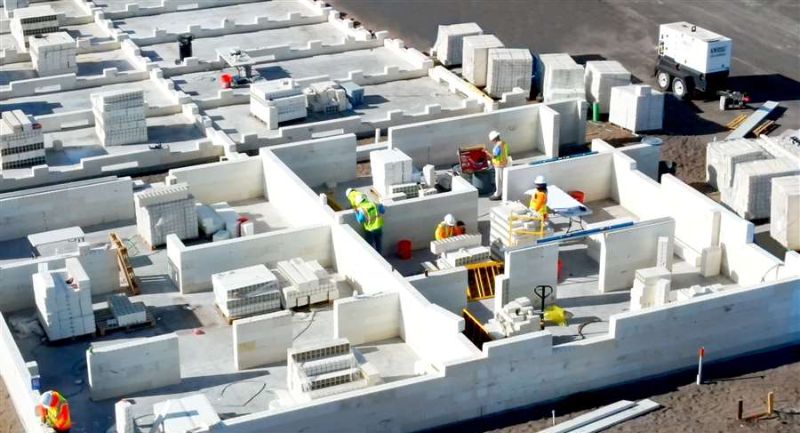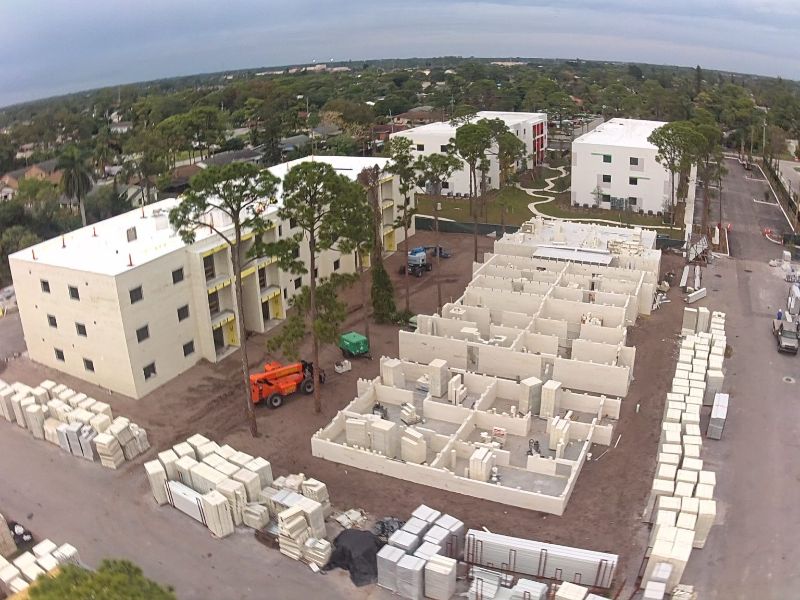Sign up to the Built Offsite Newsletter

Interlocking ‘lego’ modular building blocks by Renco: builders not required.
Emerging from the realms of playrooms to the pragmatic world of construction sites, a company with roots in both Turkey and the United States has developed a unique interlocking ‘real-life Lego kit’ for modular buildings. (main pic: Renco’s modular building blocks: construction workers trained in two hours.)
The company, RENCO, is constructing buildings using specially moulded building blocks made of composite materials, which interlock in a manner reminiscent of a well-known toy construction brand.
After dedicating over a dozen years to Research and Development and conducting 400 safety assessments, RENCO USA (Renco) launched its first residential modular building complex in the United States towards the end of 2023. Situated in Palm Springs, Florida, the complex named Lakewood Village, was informally referred to as the “Lego Project” during its development, a name first coined in 2020. This nickname arose from the design of Renco’s modular blocks, which feature knobs on the top and openings on the bottom, allowing the pieces to connect easily.

Renco described their product as “a real-life Lego kit,” consisting of moulded modular building blocks that interlock to form complete structures. This modular building method was first used in Florida, with the construction of a 96-unit building.
The technology had already been used in Turkey, where Renco manufactures its materials. There, the company constructed buildings designed to withstand earthquakes, including a hotel and several residential structures, using these interlocking modular blocks.
Renco’s modular building blocks are manufactured from 40% naturally sourced and repurposed materials, such as glass fibres, resin, and stone. “Meaning materials that were destined for the landfill are reused instead,” Renco highlighted, underscoring their commitment to sustainability and noting that a significant portion of their materials comes from the shipbuilding industry. The company also claims that their modular building blocks can withstand the force of a Category 5 hurricane.

During the construction process, the modular blocks are joined using a two-part methyl methacrylate adhesive, forming a bond stronger than the blocks themselves. Renco is expanding its reach in the American market and plans to open a new factory in Florida in their upcoming spring.
Renco also believe their composite modular building blocks and construction processes offer further advantages in terms of energy efficiency and reduced project time, while improving health, safety, and productivity onsite. “By simplifying construction into a Lego-like kit, Renco buildings can be assembled much faster, reducing time on the job and energy consumption,” the company claimed.
According to company sources, it takes approximately two hours to train an individual to build with Renco’s products, and the company points out that expert builders are not necessary for the assembly of their structures. “With 11 unskilled workers, it took about eight weeks to assemble each of the four identical three-story buildings,” Renco reported.
Watch Renco’s interlocking modular building blocks in action.
The construction process with Renco’s modular building blocks also significantly reduces waste. “At a Renco site, there aren’t big dumpsters—there is no cutting to do, since every building is like a kit,” the company explained, adding that any excess material from the moulding process is recycled back into production. With Renco blocks, crews only need about 2% extra materials, as opposed to the conventional 10% allowance for errors, with the leftovers being saved for future projects.
Despite potential concerns about transportation costs in modular construction, Renco’s lighter products (20% less weight than concrete blocks) and the absence of heavy equipment or power tools for installation is said to result in overall cost savings. “The material is so much lighter,” Renco stated. “For every one truckload of Renco’s composite materials, it takes four trucks to deliver the same number of heavy concrete blocks.”
Regarding the building materials, only a fork truck for lifting, a glue gun powered by a small generator, and a mallet are required. They’re also focused on long-term sustainability in the industry, aiming to construct facilities that can endure for nearly a century, even in harsh climate conditions. “The greenest building is the building that doesn’t need to be replaced,” Renco observed. Their buildings are designed to last two to three times longer than traditional construction methods, which typically require rebuilding every 25 to 40 years.
Renco also anticipates that clients and building owners will find cost savings in other areas as well. “It simply won’t rust or rot and nothing will consume it,” the company stated.
“We have presales already in Florida and Alaska and plan to produce enough materials to build about 5000 apartment units this year,” Renco disclosed.